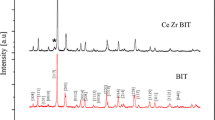The ceramics Ce0.9Bi0.1O2–δ was obtained by solid-phase synthesis. It is shown that the obtained samples possess a cubic fluorite structure with the space symmetry group Fm3m. The electrical properties of the solid solution Ce0.9Bi0.1O2–δ solid solution were investigated by means of ac impedance spectrometry. The activation energy of electric conduction falls into two regions – 0.51 eV (400 – 680°C) and 1.6 eV (680 – 800°C); dielectric relaxation is activated at 0.88 eV.






Similar content being viewed by others
References
Y. Zhang, R. Knibbe, J. Sunarso, and Y. Zhong, “Recent progress on advanced materials for solid-oxide fuel cells operating below 500°C,” Adv. Mater., 29, 1700132 (2017). URL: https://doi.org/10.3390/inorganics7100118
H. Inaba and H. Tagawa, “Review ceria-based solid electrolytes,” Solid State Ionics, 83, 1 – 16 (1996). URL: https://doi.org/10.1016/0167-2738(95)00229-4
B.Wang, B. Zhu, S. Yun, andW. Zhang, “Fast ionic conduction in semiconductor CeO2–δ electrolyte fuel cells,” NPG Asia Mater., 11, 51 (2019). URL: https://doi.org/10.1038/s41427-019-0152-8
E. L. Brosha, R. Mukundan, D. R. Brown, and F. H. Garzon, “Development of ceramic mixed potential sensors for automotive applications,” Solid State Ionics, 148, 61 – 69 (2002). URL: https://doi.org/10.1016/S0167-2738(02)00103-0
U. Nigge, H. D.Wiemhofer, E.W. J. Romer, and H. J. M. Bouwmeester, “Composites of Ce0.8Gd0.2O1.9 and Gd0.7Ca0.3CoO3 das oxygen permeable membranes for exhaust gas sensor,” Solid State Ionics, 146(1 – 2), 163 (2002). URL: https://doi.org/10.1016/S0167-2738(01)00984-5
D. He, H. Hao, D. Chen, and J. Liu, “Synthesis and application of rare-earth elements (Gd, Sm, and Nd) doped ceria-based solid solutions for methyl mercaptan catalytic decomposition,” Catalysis Today, 281, 559 – 565 (2017). URL: https://doi.org/10.1016/j.cattod.2016. 06.022
A. Vita Catalytic, “Applications of CeO2-based materials,” Catalysts, 10, 576 (2020). URL: https://doi.org/10.3390/catal10050576
Y. Zhang, Ch. Lenser, and N. H. Menzler, “Comparison of solid oxide fuel cell (SOFC) electrolyte materials for operation at 500°C,” Solid State Ionics, 344, 115138 (2020).
P. Ramos-Alvarez, M. E. Villafuerte-Castrejón, G. González, and M. Cassir, “Ceria-based electrolytes with high surface area and improved conductivity for intermediate temperature solid oxide fuel cells,” J. Mater. Sci., 52(1), 519–532 (2017).
J. Wang, S. Chen Xie, et al., “Bismuth tungstate/neodymium-doped ceria composite electrolyte for intermediate-temperature solid oxide fuel cell: Sintering aid and composite effect,” J. Power Sources, 428, 105 – 114 (2019).
H. Hu, H. Yan, and Z. Chen, “Sintering and electrical properties of Ce0.8Y0.2O1.9 powders prepared by citric acid-nitrate low-temperature combustion process,” J. Power Sources, 163, 409 – 414 (2006).
L. Bouria, B. Bakiz, A. Benlhachemi, et al., “Electrical properties of a CeO2–Bi2O3, mix system elaborated at 600°C,” Adv. Mater. Sci. Eng., No. 2, 1 – 11 (2012). https://doi.org/10.1155/2012/452383
G. Accardo, D. Frattini, H. C. Ham, and S. P. Yoon, “Direct addition of lithium and cobalt precursors to Ce0.8Gd0.2O1.95 electrolytes to improve microstructural and electrochemical properties in IT-SOFC at lower sintering temperature,” Ceram. Int., 45(7), pt B, 9348 – 9358 (2019).
D. J. L. Brett, A. Atkinson, N. P. Brandon, and S. J. Skinner, “Intermediate temperature solid oxide fuel cells,” Chem. Soc. Rev., 37, 1568 – 1578 (2008).
D. Liu, D. Ding, M. Liu, et al., “High-performance, ceria-based solid oxide fuel cells fabricated at low temperatures,” J. Power Sources, 241, 454 – 459 (2013).
G. Accardo, D. Frattini, H. C. Ham, and J. H. Han, “Improved microstructure and sintering temperature of bismuth nano-doped GDC powders synthesized by direct sol-gel combustion,” Ceram. Int., 44, 3800 – 3809 (2018). URL: https://doi.org/10.1016/j.ceramint.2017.11.165
G. Accardo, D. Frattini, H. C. Ham, and S. P. Yoon, “Direct addition of lithium and cobalt precursors to Ce0.8Gd0.2O1.95 electrolytes to improve microstructural and electrochemical properties in IT-SOFC at lower sintering temperature,” Ceram. Int., 45, 9348 – 9358 (2019). URL: https://doi.org/10.1016/j.ceramint.2018.07.209
S. Sanna, V. Esposito, M. Christensen, and N. Pryds, “High ionic conductivity in confined bismuth oxide-based heterostructures,” Apl. Mater., 4, 12110 (2016). URL: https://doi.org/10.1063/1.4971801
X. L. Chen and W. Eysel, “The stabilization of β-Bi2O3 by CeO2,” J. Solid State Chem., 127, 128 – 130 (1996).
L. Bourja, B. Bakiz, A. Benlhachemi, et al., “Structural and Raman vibrational studies of CeO2–Bi2O3 oxide system,” Adv. Mater. Sci. Eng., No. 2. 1 – 4 (2009).
I. V. Zagaynov, S. V. Fedorov, A. A. Konovalov, and O. S. Antonova, “Perspective ceria-based solid solution of GdxBi0.2–xCe0.8O2,” Mater. Lett. 203. 9 – 12 (2017).
Z.-C. Li, H. Zhang, and B. Bergman, “Synthesis and characterization of nanostructured Bi2O3-doped cerium oxides fabricated by PVA polymerization process,” Ceram. Int., 34, 1949 – 1953 (2008).
S. Dikmen, P. Shuk, and M. Greenblatt, “Hydrothermal synthesis and properties of Ce1–xBixO2–δ solid solutions,” Solid State Ionics, 11, 299 – 307 (1998).
G. Li, L. Li, S. Feng, Yao, et al., “An Effective Synthetic Route for a Novel Electrolyte: Nanocrystalline Solid Solution of (CeO2)1–x(BiO1.5)x,” Adv. Mater., 11(2), 146 – 149 (1999).
G. Accardo, L. Spiridigliozzi, G. Dell’Agli, et al., “Morphology and structural stability of bismuth-gadolinium Co-doped ceria electrolyte nanopowders,” Inorganics, 7, 118 (2019). URL: https://doi.org/10.3390/inorganics7100118
K. P. Padmasree, R. A. Montalvo-Lozano, S. M. Montemajor, and A. F. Fuentes, “Electrical conduction and dielectric relaxation process in Ce0.8Y0.2O1.9 electrolyte system,” J. Alloys Compds., 509, 8584 – 8589 (2011).
R. Gerhardt, “Impedance and dielectric spectroscopy revisited: Distinguishing localized relaxation from long-range conductivity,” J. Phys. Chem. Solids, 55, 1491 – 1506 (1994). URL: https://doi.org/10.1016/0022-3697(94)90575-4
M. Kurumada, H. Hara, and E. Iguchi, “Oxygen vacancies contributing to intragranular electrical conduction of yttria-stabilized zirconia (YSZ) ceramics,” Acta Mater., 53(18), 4839 – 4846 (2005). URL: https://doi.org/10.1016/j.actamat.2005.06.027
N. J. Kidner, N. H. Perry, T. O. Mason, “The brick lauer model revisited: Introducing the nanj-grain composite model,” J. Am. Ceram. Soc., 91(6), 1733 – 1746 (2008). URL: https://doi.org/10.1111/j.1551-2916.2008.02445.x
S. Ramesh, “Transport properties of Sm doped CeO2 ceramics,” Proc. Appl. Ceram., 15(4), 366 – 373 (2021). https://doi.org/10.2298/PAC2104366E
A. Pimenov, J. Ullrich, P. Lunkenheimer, et al., “Ionic conductivity and relaxations in ZrO2–Y2O3 solid solutions,” Solid State Ionics, 109(1 – 2), 111 – 118 (1998). URL: https://doi.org/10.1016/S0167-2738(98)00082-4
H. Yamamura, S. Takeda, and K. Kakinuma, “Relationship between oxide-ion conductivity and dielectric relaxation in Sm-doped CeO2,” Solid State Ionics, 178(13 – 14), 889 – 893 (2007). URL: https://doi.org/10.1016/j.ssi.2007.04.013
K. P. Padmasree and D. K. Kanchan, “Conductivity and dielectric studies on 20CdI2– 80[xAg2O – y (0.7V2O5– 0.3B2O3)] super ion conducting system where 1 ≤ x/y≤3,” J. Non-Cryst. Solids, 352(36 – 37), 3841 – 3848 (2006). URL: https://doi.org/10.1016/j.jnoncrysol.2006.06.012
Author information
Authors and Affiliations
Corresponding author
Additional information
Translated from Steklo i Keramika, No. 3, pp. 26 – 32, March, 2023.
Rights and permissions
Springer Nature or its licensor (e.g. a society or other partner) holds exclusive rights to this article under a publishing agreement with the author(s) or other rightsholder(s); author self-archiving of the accepted manuscript version of this article is solely governed by the terms of such publishing agreement and applicable law.
About this article
Cite this article
Sudzhanskaya, I.V., Sotnikova, V.S. Electrical Characteristics of Bismuth-Containing Cerium Oxide. Glass Ceram 80, 100–104 (2023). https://doi.org/10.1007/s10717-023-00565-x
Received:
Published:
Issue Date:
DOI: https://doi.org/10.1007/s10717-023-00565-x




